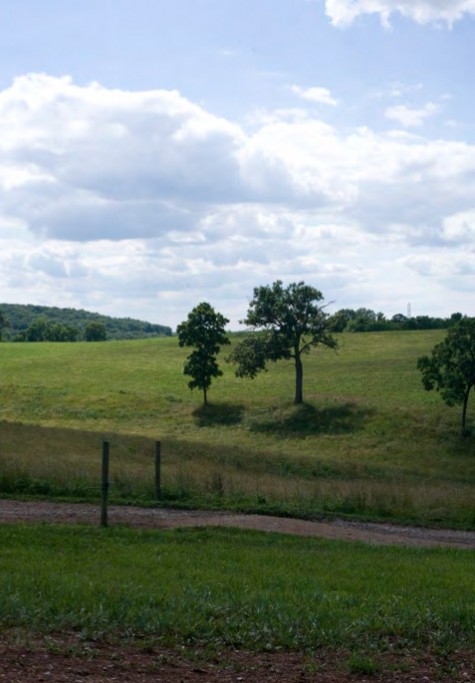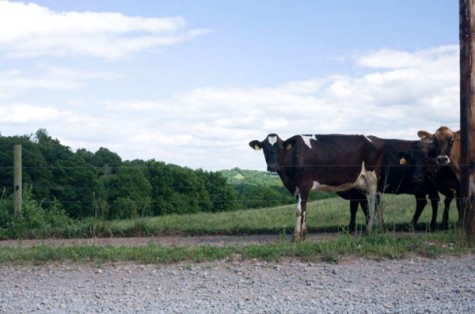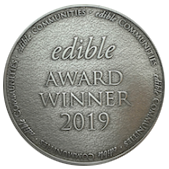I spent two days this week, two glorious days, with Julie Kramer, the publisher of Edible Ohio Valley magazine, visiting Snowville Creamery in Southeastern Ohio. The creamery itself is a metal-clad building that occupies a piece of The Brick, the dairy farm whose milk is bottled there. It’s a Rube Goldbergian setup of pipes and vats that safely and efficiently turn milk into two-percent, skim and the most wonderful whipping cream you’ll ever come across (this is what I use to make butter). Depending on the day, the milk goes from cow to creamery to my grocery shelf in Cincinnati within 24 hours. Talk about farm-to-table.
And it matters. This is important stuff, people.
We’re very quickly losing farmland to development, about one acre per day in the U.S. Increasingly, small dairy farms are throwing in the towel because they no longer get a decent price from huge food conglomerates and milk production is concentrated among large operations.
Ever drive north from Indianapolis toward Chicago? Then you’ve seen the billboards for Fair Oaks Farms north of Lafayette. You’ve seen the enormous barns, the huge waste lagoons. Know what you haven’t seen? Cows. Think about that.
At The Brick, you’ll see cows, all 270 of them, meandering the hillsides munching grass. Grass. The cows eat grass. They’re outside. They come into the milking parlor twice a day, and what they give goes straight from the animal to the creamery. Snowville milk tastes like milk, not water and additives. It’s gently pasteurized to maintain flavor and nutrients, and it’s not homogenized, so the cream rises to the top. It changes with the season. Right now, it’s grassy-tasting; in summer, it’ll be a bit sweeter from the clover in the pasture. The butter I made last weekend was an almost shocking shade of bright yellow; I’m told the cows have been eating the dandelions in the field all spring.
Used to be, there were small family-owned farms all over rural America, and small creameries and butchers and independent deliverymen processing and bringing all this good stuff to customers within a 100-mile radius or so. Even city folk would get food that was produced in the same county or region. Local was the norm.
These days, agriculture and food production happens on a huge scale, in concentrated parts of the country, and gets shipped to us. Even in late spring, those tomatoes you’re buying in the grocery are coming thousands of miles from California or Mexico. Small dairy farmers don’t use county co-ops; their cows’ milk goes to some centralized processing plant where it’s mixed up with milk from all over the place, boiled to make it last longer (which cooks off the bacteria, and also the flavor, the enzymes and the nutrients) and shipped hundreds of miles.
The families who persevere—who sink their savings and retirement into caring for their animals, who plant and pick produce, who handle delivery themselves and work 8-day weeks and never get vacation—these people deserve our thanks and our support. They’re on the crazy side of crazy, and they’re doing important work.
Buy a carton of Snowville (it’s cheaper than organic!). Purchase beef and poultry from the local farmers selling at your neighborhood market. Stop at the roadside stand to get tomatoes. Shop farmers’ markets. In some cases, you’ll pay no more than you would at the grocery; in some cases, you’ll pay a little more; in some cases, a lot more. Think about what you’re getting, and what went into it. Our national food system is broken, and the people who run it aren’t at all motivated to change anything. It’s up to us to vote with our dollars. We have to take responsibility for making food healthier. Our lives depend on it.
So, what do you think? Do you prefer to buy local or do you seek other options? Does price matter to you? You’re invited to share your thoughts in the Comments — I’d like to create a conversation!
Photos: Julie Kramer







Great post, both content and style. Snowville’s is a great product, makes wonderful whipped cream for the now gone strawberries. Thanks for highlighting local producers.
Great post. I am all for locally grown foods, and try to maintain that in my home, and business. People forget that organic is how it’s always been…the massive turn we’ve taken to shipping our food is a relatively new concept considering how it ‘used to be’.
Hey, Chef — thanks for the comment. We LOVE your place in Bloomington (in fact, we’re planning a weekend trip from Cincinnati, including a massive shopping excursion to the farmers’ market and dinner at FARM, in the next 3 weeks or so). I’ve long admired the work you do with highly local ingredients. Thanks!
This is a terrific post both in the message and the delivery. The localization of food benefits our lives in so, so many ways. It’s not too late to turn this thing around.
Pingback: Adjusting to life as a freelance writer. | writes4food | cooking, eating, drinking in the Midwest
Great post. Thank you. I am new to the area so I am not familiar with the Snowville product, but your description of their milk is exactly how milk should be!
Pingback: Crunchy Friday 7/8/11 | Mashup Mom
Pingback: The challenge of eating locally. | writes4food | cooking, eating, drinking in the Midwest
Pingback: We love Snowville. | writes4food | cooking, eating, drinking in the Midwest